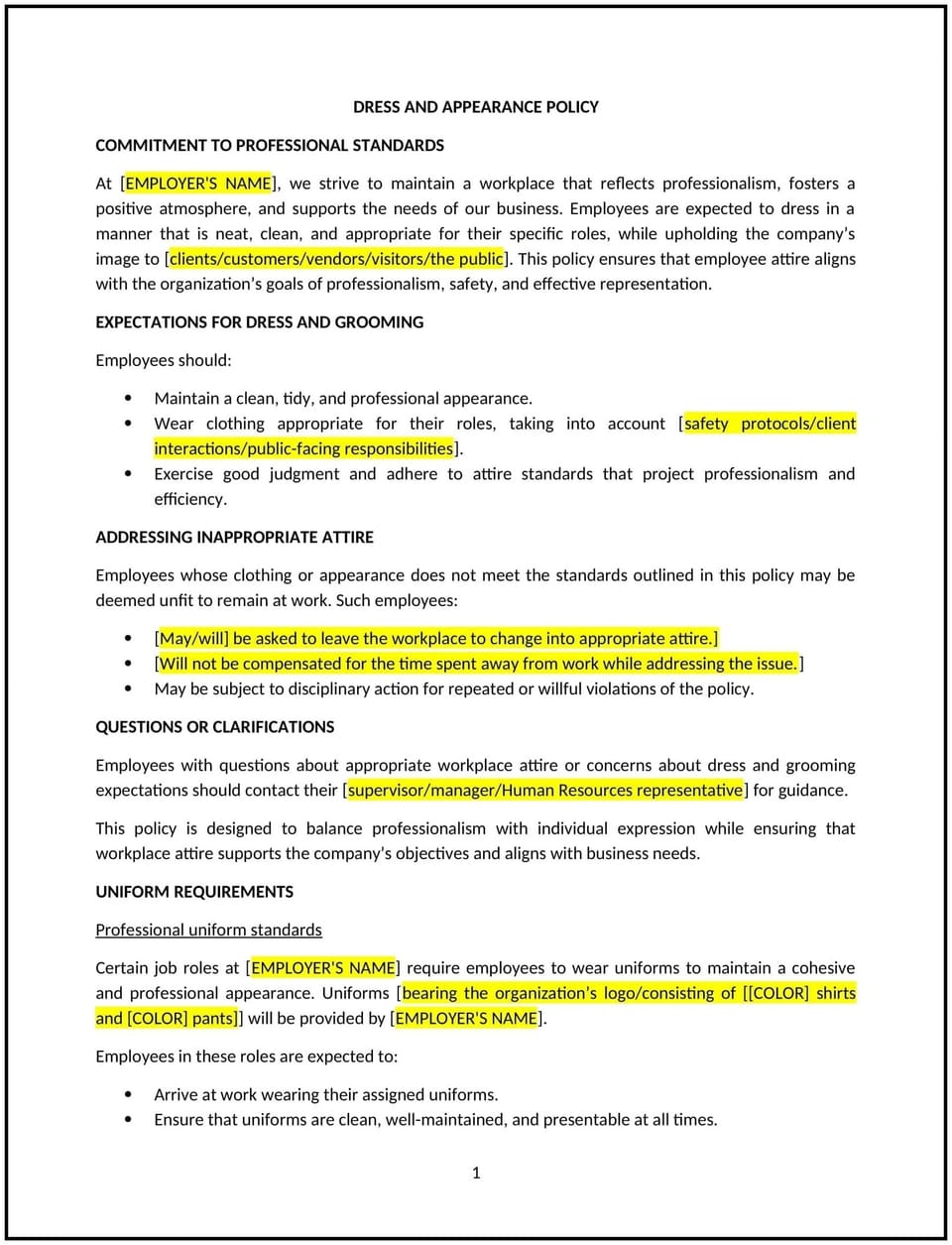Dress and appearance policy (Michigan): Free template

Dress and appearance policy (Michigan)
A dress and appearance policy provides Michigan businesses with guidelines for appropriate attire and personal grooming in the workplace. This policy ensures that employees present themselves in a professional manner while accommodating cultural, religious, and medical needs. It helps businesses maintain a positive work environment, promote workplace safety, and align employee appearance with the business’s image and brand.
By adopting this policy, businesses can create a clear understanding of dress expectations, enhance professionalism, and ensure inclusivity while maintaining an environment conducive to productivity.
How to use this dress and appearance policy (Michigan)
- Define appropriate attire: Specify what constitutes acceptable attire for different work settings (e.g., business casual, uniform, or casual) and include guidelines for specific roles or departments that may have unique dress requirements (e.g., customer-facing roles or safety-sensitive positions).
- Accommodate cultural and religious attire: Provide provisions for accommodating cultural, religious, or disability-related attire, ensuring that employees’ personal beliefs are respected while maintaining the professionalism of the workplace.
- Set grooming expectations: Outline expectations for personal grooming, such as cleanliness, hair length or style, facial hair, and nail care, while ensuring that the policy respects personal choices and diversity.
- Address safety-related dress codes: For positions involving physical labor or machinery, specify safety-related clothing requirements, such as protective gear, uniforms, or non-slip shoes, to ensure a safe work environment.
- Establish dress-down days: If applicable, define dress-down days or casual Fridays, clearly explaining when employees may dress more casually and any exceptions to the general dress code during these times.
- Include consequences for non-compliance: Specify the steps to be taken if an employee does not adhere to the policy, which may include informal discussions, warnings, or disciplinary actions for repeated violations.
- Promote inclusivity: Ensure the policy is designed to be inclusive, considering the diverse needs and expressions of employees while maintaining professional standards for appearance in the workplace.
Benefits of using this dress and appearance policy (Michigan)
This policy provides several key benefits for Michigan businesses:
- Promotes a professional image: A clear dress and appearance policy helps maintain a professional environment, ensuring that employees present themselves appropriately for clients, customers, and colleagues.
- Supports workplace safety: By specifying safety-related dress requirements, the policy helps prevent accidents and injuries, particularly in environments that require protective gear or uniforms.
- Enhances employee productivity: A well-defined policy creates clarity and consistency regarding expectations, reducing confusion and potential conflicts about what is acceptable to wear in the workplace.
- Fosters inclusivity and respect: The policy accommodates cultural, religious, and disability-related clothing needs, fostering an inclusive environment where employees feel valued and respected.
- Reduces workplace distractions: Clear guidelines help prevent inappropriate or disruptive attire, maintaining focus on work and avoiding distractions or discomfort among employees.
Tips for using this dress and appearance policy (Michigan)
- Communicate the policy: Ensure that employees are aware of the dress and appearance policy by including it in the employee handbook, during onboarding, and via regular internal communications.
- Involve employees in policy development: Consider consulting employees or employee representatives when developing or revising the policy, to ensure that it is inclusive and considers their needs and preferences.
- Address exceptions: Clearly outline any exceptions to the policy for medical, religious, or cultural reasons and ensure the policy is applied fairly across all employees.
- Provide flexibility: While maintaining professional standards, offer flexibility, especially in roles that do not have direct customer interaction, allowing employees to express themselves within reason.
- Review periodically: Regularly review the policy to ensure it remains up to date with Michigan laws, company culture, and any evolving trends or workplace needs.
Q: What types of clothing are considered appropriate under this policy?
A: Appropriate attire will depend on the workplace setting, but typically, business casual or uniform dress codes apply. The policy should specify what is acceptable for different roles and departments.
Q: Can employees wear religious or cultural attire?
A: Yes, businesses should make provisions to accommodate cultural or religious attire, ensuring that all employees can dress in accordance with their beliefs while still adhering to the overall professional standards of the workplace.
Q: What are the expectations for personal grooming?
A: The policy should outline basic grooming expectations, such as cleanliness, neatness, and appropriate personal care, while respecting individual choices regarding hair length, facial hair, and grooming.
Q: What should employees wear for safety-sensitive roles?
A: Employees in roles requiring safety measures should wear appropriate clothing and protective gear, such as helmets, gloves, non-slip shoes, or uniforms, as required for their specific tasks.
Q: Can employees dress more casually on certain days?
A: Businesses can allow casual dress days, such as “dress-down Fridays,” where employees can wear more casual attire, as long as it remains professional and in line with the company’s image.
Q: What happens if an employee does not follow the dress code?
A: Employees who do not adhere to the dress code may be asked to return home to change into appropriate attire or receive a warning for repeated violations. The policy should specify progressive discipline measures for non-compliance.
Q: How often should this policy be reviewed?
A: The dress and appearance policy should be reviewed periodically to ensure it aligns with Michigan laws, the evolving workplace environment, and any changes in industry standards or company culture.
Q: Can employees express their individual style?
A: While individual style is encouraged, employees should be mindful of the company’s expectations for professionalism and safety. The policy should balance personal expression with maintaining a respectful and cohesive work environment.
This article contains general legal information and does not contain legal advice. Cobrief is not a law firm or a substitute for an attorney or law firm. The law is complex and changes often. For legal advice, please ask a lawyer.


